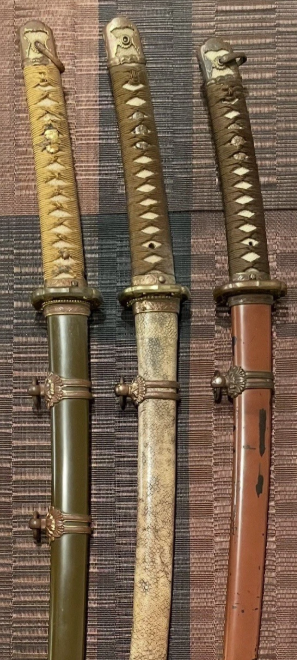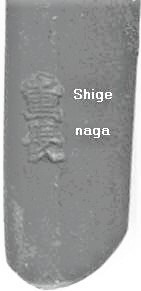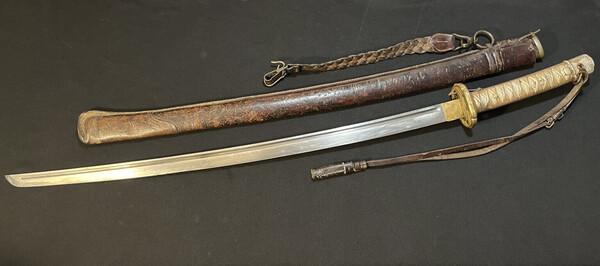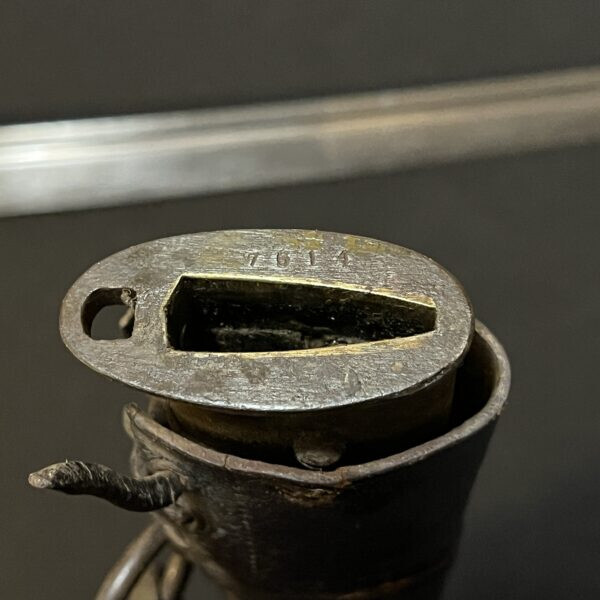-
Posts
13,849 -
Joined
-
Last visited
-
Days Won
169
Content Type
Profiles
Forums
Events
Store
Downloads
Gallery
Everything posted by Bruce Pennington
-

Help with Blade Condition
Bruce Pennington replied to PEF87's topic in General Nihonto Related Discussion
I see no images on those links, either. -

NMB Guntō Auction - All Proceeds to the Forum!
Bruce Pennington replied to Scogg's topic in Swords and Edged Weapons
And a special thanks to the anonymous donor! -
Sam, I have a copper and a Pattern 5, both back in Colorado (I'm in CA until January). If you don't get the shots you need before then, I'll get some to you. I have some pics on my laptop, but they're not as good as you'd like for your work.
-
-
John, I haven't been tracking then (I know, what a shocker! Ha!) Maybe @Kiipu or @BANGBANGSAN What I find very interesting, is the Type 94 with offset chuso (Yes, John @PNSSHOGUN has pointed this out) and the Type 98 with centered chuso:
-
Hi Eric, I am learning as we go with the kyugunto. Dawson, page 63, says your backstrap pattern is of the Type 19 kyugunto. He also states the second suspension mount was removeable on the 19s. If it is not, then this might be a Type 8. Is the blade signed? Can we get some shots of the nakago (tang)?
-

Type 98 Koshirae w/ Small Size "Shige" Mei on Nakago
Bruce Pennington replied to Klink's topic in Military Swords of Japan
After looking it over more, I don't think it is stamped . Appears to be hammer and chiseled. -
Too bad about the openings in the steel, yet I bet this hamon would be stunning with a polish. Don't know the terms, but you can get a lesser expensive polish that cleans the blade up a bit and brings out the beauty. For the record, I don't study nihonto, just commenting on the attractiveness of that hamon.
-
Michael, In general, Type 19s with fighting blades did exist. Dawson shows them in his book, and calls them Type 19 kyugunto. I can't say whether we've seen any show up here at NMB. I'd say it is plausible that his was legit, however your theory is just as possible. Does the blade fit well in the saya?
-
Jens, Here is Akira-san's answer to your original questions. Also note, the Google translation incorrectly stated "officers working in government offices...". It said NCOs, which now is perfectly understandable. "However, the gist of it is that sergeant majors in artillery units other than those in Heavy Field Artillery Regiments 7 & 8, Antiaircraft Artillery and Heavy Artillery units carried the Type 32 Otsu sword and the Type 14 pistol, whereas those in the Heavy Field Artillery Regiments 7 & 8 and Antiaircraft Artillery wore the Type 30 Bayonet and the Type 14 pistol while Sergeant Majors in Heavy Artillery Units only wore the Type 32 Otsu Sword. I believe the reason sergeant majors in Heavy Field Artillery Regiments 7 & 8 and Antiaircraft Artillery wore the bayonet instead of the sword was probably because these units were motorized units which used tractors to pull their artillery pieces. Sergeants and below in artillery units except mounted artillery just carried the Type 30 bayonet while NCOs in Mounted Artillery regiments carried the Type 14 pistol in addition to the bayonet. Sergeant Majors in all other units except Transportation, Military Police and Motor Transport School carried just the Type 32 Otsu sword, while the excluded units carried in addition to the sword, also the Type 14 pistol. Sergeants and below in Transportation units also carried the Type 32 Otsu sword in addition to the Type 38 Carbine. Note has to be taken that in transportation units there used to also be uniformed coolies designated Transportation Special Duty Soldiers who were only issued the bayonet. Interestingly, of the pioneer branch units, sergeants and below in sapper units carried the Type 38 rifle and Type 30 bayonet while Railroad Units and Communication Troops which also belonged to the Pioneer Troops carried the type 30 Carbine. As for military policemen, all ranks (the lowest rank in the Military Police was superior private, who, unlike enlisted men in other branches except musicians, held the position of a government employee) carried the Type 32 Otsu Sword. In addition, it is stated in the notes that those military policemen stationed in Korea, Taiwan and Kwangtung be also issued the Type 38 carbine in addition to the Type 32 Otsu Sword and Type 14 pistol. I think the portion Bruce-san refers to in his post is Note 2 on the chart's margin which states that NCOs attached to 官衙 government offices, headquarters, materiel depots, etc. were to carry the Type 32 sword. The higher echelons in the army such as the Army Ministry, Army General Staff and the various administrative offices in the army were categorized as government offices. I forgot to mention in my previous post but on note 7 of the chart it is stated that the equipment of students 生徒 in the military academy is to be the same as enlisted men in the infantry, i.e., Type 30 bayonet and Type 38 rifle. Students in the first 2 years of the Military Academy prior to service in units were referred to as “students”, 生徒 whereas once they returned after having served for 6 months in units were referred to as “candidates”, 候補生. This tradition continued after the first 2 years was spun off as the Army Officer Preliminary School, 陸軍予科士官学校 dispelling the theory that the sword with the mei 予士63 in this thread was issued to students in the Army Officers Preliminary School: Mei: "Cadet 63"?"
-

Type 98 Koshirae w/ Small Size "Shige" Mei on Nakago
Bruce Pennington replied to Klink's topic in Military Swords of Japan
Wow, John, you are absolutely right! looking through the JSI list, it could be: 清重 (Kiyoshige). I'll have to file this. -

Type 98 Koshirae w/ Small Size "Shige" Mei on Nakago
Bruce Pennington replied to Klink's topic in Military Swords of Japan
That's an odd one, Dean. I have a Shigenaga on file that used a stamped mei, but yours doesn't have the "naga." For the guys to comment on the age/school of the blade, you'll need to post a full-length photo and a couple of shots of the hamon and boshi. -
Yeah, dealer prices always over the top.
-

Nlf Gunto Discussion
Bruce Pennington replied to Bruce Pennington's topic in Military Swords of Japan
Good catch John. I hadn’t noticed that. It goes along with the rest of the fittings not being gold gilded. Kind of supports the idea that they were using surplus parts initially. -
Here's one that checks all the boxes at this St Croix sale: Type 95 Leather covered, tassel, battle damage, early matching Suya Shoten with accurate wrap with screw through the wrap:
-

Help with Type 98 Shin-Gunto Mei - Seki Stamped
Bruce Pennington replied to tbonesullivan's topic in Translation Assistance
@tbonesullivan - David, is it possible to get a shot showing the stamp? -
Maybe we can get your answers from @Kiipu @BANGBANGSAN and/or @SteveM? In addition to Jens' question, could I get a double-check on the google translate John provided concerning officers in government buildings and police officers being assigned the Type 32 for wear?
-

Wakizashi tameshigiri edo
Bruce Pennington replied to Hiro nakamura's topic in Translation Assistance
Average waki - $600 Above average- I’ve seen $2,600 Important blade- higher -
@Scogg after the translating is complete here, how about moving this over to the military section. I think it would be of interest to the guys that collect Type 32s.
-
Ah, I thought I recognized the red annotations. If you don’t get help here, I recommend taking the chart to Akira Komiya, Nick’s brother who is currently active on Warrelics. Or I can post it for you.
-
Who did the translating on this chart? Did you do this, or is it something from Nick Komiya?
-
The stamp was used from 1935 to 1942, with most dated blades found from 1940-1941.
-
Quite interesting to see "Officers at government offices" and "military police" being assigned the Type 32 Otsu! Hmmm











